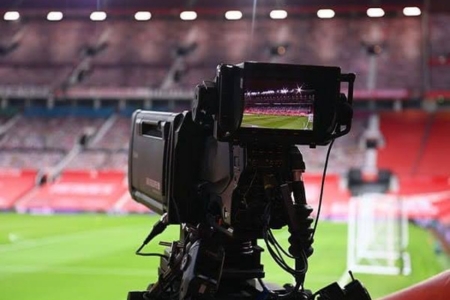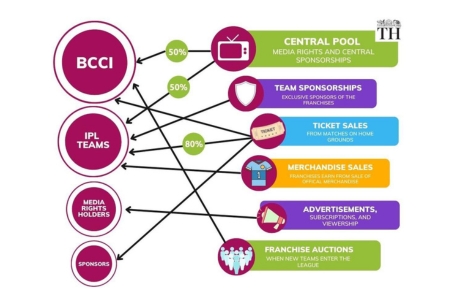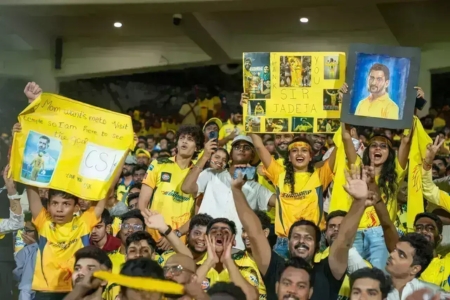Understanding the IPL Business Model: A Global Comparison of Sports Leagues


Table Of Content
Indian Premier League, or IPL, has transformed the business of sports and redefined it into a global, most successful, and recognized league in the world from what was originally a cricketing domestic competition. Its high-octane cricket with entertainment has mesmerized millions of people, thereby becoming a machine that generates an amount of revenue without precedent. This includes the multi-million-dollar broadcasting deal, the strategic sponsorships, and a diverse roster of players. The IPL business model is a perfect case in modern sports management, and hence, we take the lead here to break down the elements responsible for their financial success by comparing the league with others at the top of global leagues as well as how it grows further.
Overview of the IPL Business Model
Since its formation in 2008, the Indian Premier League has been one of the strongest and wealthiest sporting leagues worldwide. IPL's success was attributed to its unique business model which brings cricket on a global scale and huge commercialization along with the entertainment model. What makes IPL so appealing is that it offers a very attractive product, as it puts together competitive T20 cricket and glamorous entertainment with international sponsorship and star player auctions. The revenues generated by it are diversified through lucrative broadcasting deals, sponsorships, merchandise sales, and ticket revenues. The IPL has long stretched across the borders of India capturing millions of viewership in international markets and becoming an integral part of global sports markets. It was through its ability to hook up a huge fan base and maximize media rights, combined with incorporating a diverse pool of stakeholders, that this league propelled itself to a forefront position, making it among the most valuable sports franchises globally, competing directly against the NBA, EPL, and NFL.

Key Revenue Streams in the IPL Business Model
Broadcasting and Media Rights
Media rights provide the bedrock for IPL's revenue model. With it, the league earned billions of dollars. Its broadcast deal with Star India and more recently with Viacom18 is one of the highest-paid deals in sports history. These deals span traditional television to digital streaming, thereby allowing fans from India and beyond to watch the games through a variety of means. Digital streaming has been a driving force for the league to reach out to more people worldwide, especially the young generation, ever since the entry of services like Disney+ Hotstar. Through digital platforms, there is more flexibility and accessibility, making the IPL accessible to millions across the globe. As viewership continues to increase, the IPL's capacity to realize premium prices for its media rights ensures its financial muscle and its global repute, so it is a model that other sports leagues are pursuing to leverage broadcasting for success in the long term.

Sponsorship and Brand Partnerships
Sponsorships are a large source of revenue for IPL, as many brands seek to partner with the league because of its enormous reach and high-profile platform. The IPL attracts the most prominent global sponsors in all major industries, from technology to consumer goods- brands like Tata, and Vivo, who are the title sponsors, and so on. The league's sponsorship model goes beyond the title sponsor since each team has its group of corporate sponsors, contributing to the league's revenue. These partnerships provide a lot of visibility for brands during live broadcasts and through extensive digital and social media campaigns. With IPL, national as well as international sponsors feel strongly about signing contracts to be affiliated with it, thereby strengthening its positioning as one of the world's most valuable sports leagues.

Ticket Sales and Merchandise
Ticket sales and merchandise are a significant part of the IPL's revenue generation, and this reflects the strong engagement that the league commands among fans. Fans flock to the grounds scattered all over India for an electrifying atmosphere, and through dynamic crowds and events engaging those attending. Revenue through selling tickets is important in maintaining the league and its affiliated franchises' financial sustainability. Retailing official merchandise like jerseys and hats, as well as other memorabilia, creates a lot of revenue for them too. IPL uses its widespread popularity to sell exclusive merchandise both at the stadium and online, which adds another dimension to its commercial viability. These revenue streams with exciting cricket on display make a loyal fan base, and IPL is then an all-rounded entertainment that goes beyond the game itself.

Cost Structure in the IPL Business Model
Player Salaries and Auctions
The IPL player auction is an event in which the auctions have a considerable impact on team budgets and overall league dynamics. In the course of the auction, franchises will bid for the players, with each team having an allocated budget for building up its squad. The nature of the auction process often involves a fierce battle, especially for the big stars, resulting in record-breaking salaries. Top players can command multi-million-dollar contracts, whereas lesser-known or up-and-coming talent may be bought for relatively modest sums. This auction system has transformed IPL teams into franchises with the financial flexibility to attract global talent. At the same time, high salaries to the players increase pressure on the team's budget which pushes franchises to balance a need for having star power alongside a well-rounded team. Performance potential, pop culture status, and marketability-based bidding wars push the player price even more, setting up the IPL as the most attractive and lucrative cricket-playing marketplace globally.
Franchise and Operational Costs
Running an IPL franchise requires a tremendous upfront investment in terms of participating fees, renting stadiums, hiring players, and logistics. For every franchise, there is a substantial amount they have to pay to get a franchise from the IPL which can range from tens of millions to hundreds of millions based on the market value of the franchise. Besides this, franchises have perpetual expenses such as stadium rentals when the franchise plays at home, as ticket sales and event-related revenues will pay for these costs. Team management, coaching staff salaries, logistics in traveling and staying, and marketing expenses to market the franchise are all considered operational expenses. For many teams, the costs of quality facilities, sponsorships, and engagement of fans add up fast. Ticket sales and merchandise offset these costs in some measure, but the net cost burden requires franchises to exploit every commercial opportunity to sustain their franchise in terms of profitability and growth through continuous good performances in the tournament.

Comparing the IPL Business Model with Global Sports Leagues
Revenue Sharing and Profit Distribution
This model in the IPL's revenue-sharing is significantly different from other global sports leagues. Here, for instance, in leagues such as the NFL and NBA, there is a much more structured revenue-sharing system in place with most of the league revenue, especially the broadcasting revenue, shared equally by the franchises. This level of balance makes for healthy competitiveness between teams financially. However, the IPL works in a more centralized model in which most of the income earned through the sale of rights of telecasting and sponsors goes towards the league as such and gets distributed by team performance and market value as well as specific deals. While IPL franchises get media rights and sponsorships, the distribution is not as uniform as it is in the NBA or NFL. This model encourages franchises to do well both on and off the field for maximum earning, making this highly competitive and driving innovations in marketing and fan engagement.

Brand Value and Global Appeal
The IPL has added tremendous brand value to compete with the world's sport's premier leagues, most notably EPL and the NBA. Although the former two leagues have garnered international crowds in the main, predominantly European and North American geographical locations, the IPL has established a rather quick expansion base internationally in markets such as the Middle East, South East Asia, and to an extent, North America. It will give the league an international feel as players from various cricketing nations will come under one umbrella. The IPL also has captured the youth worldwide with its entertainment mix and the rise of digital streaming. In terms of brand value, the league is growing along with massive broadcasting deals and the attraction of top global sponsors. With continued engagement with international fans through localized content and digital platforms, the IPL is well poised to compete with, if not better, the global appeal of some of the most established leagues.

Player Participation and League Structure
Player participation as well as the structure of the league in the IPL is quite different from a traditional global league, which is the NBA or the Premier League. IPL runs along a franchise-based model and allows teams to purchase the players through an annual auction; this process creates very intense competition for prime talents, and the talent is drawn from both domestic and international sources. Leagues such as the NBA and EPL, for example, are long-term contracts, where players are drafted or signed by teams, and transfer rules depend on the specific market periods. International players play a vital role in the IPL because the league has a diverse player base representing countries from around the world. This international inclusion not only enhances the competitiveness of the league but also broadens its global fanbase. In contrast to a more stable player structure in NBA or EPL, this makes IPL flexible with players and their contracts, hence a very dynamic and unpredictable competition.
Success Factors of the IPL Business Model
The Role of Marketing and Fan Engagement
With strong marketing campaigns and fan engagement initiatives, the IPL has gained mass popularity. It converges traditional media strategy along with innovative digital tactics with other age groups and cultures into one. It takes advantage of social media tools, such as Twitter, Instagram, and YouTube to generally create a buzz surrounding the tournament with behind-the-curtain pictures, players' interactions, and match live updates. The teams also use regional marketing to tap into the local audience to strengthen the league's national reach. Fan zones that allow fans to meet and greet players, play games, and enjoy the live action have added to the engagement. It also accessed the digital platforms including Disney+ Hotstar through which live matches and other exclusive content were provided to the fans. This created more engagement of the fans as the connection remained long-lasting hence, the IPL became a phenomenon on the cricketing field as well as outside the grounds.

Innovative Formats and Entertainment Value
The format of IPL, mainly the T20 format, has changed cricket into serving a fast-paced and highly energetic product that attracts both traditional viewers and new crowds. T20 cricket, by its very nature, is short and action-packed, thus the games are always interesting and can be completed within a few hours, hence it is accessible to the modern-day audience with hectic schedules. The IPL has some entertainment elements of live music, cheerleaders, and the involvement of celebrities that make it different from other leagues, such as Test cricket or even the longer formats like ODI cricket. Innovations in combination with state-of-the-art technology applied for analysis of players and fan engagement create a unique viewing experience. IPL matches are not just about the game but also about providing an all-encompassing entertainment experience, which attracts a diverse global audience and establishes it as an entertainment-driven sports league.
Challenges and Future Outlook for the IPL Business Model
Expanding into New Markets
The IPL has an excellent opportunity to break into the unexploited global markets. Since cricket is hugely popular in countries such as Australia, South Africa, and England, this might give the IPL more possibilities for increasing its global influence. This is through digital platforms since these have made the process of reaching out to new audiences both economical and accessible. By having streaming deals, as such as it did recently with Disney+ Hotstar, collaboration by the league increases their fan base that might exist in areas not typically reachable by traditional broadcasts. Thereby, creating more space with local content and regional-based marketing of its teams; this can take the game even closer to audiences throughout the world. In other words, because the IPL is continually adapting and modernizing, there is a propensity to grow and gain much more global support.

Balancing Commercial Interests with Player Welfare
Balancing the enormous commercial success of the IPL with the interest of keeping its players financially well represents a challenge that it poses. The heavily packed match series and tournament within a league schedule most likely causes burnout, and injures some players, thus impacting performance and eventually leading to an incomplete career. For this purpose, IPL must focus more on player well-being by imposing adequate resting periods, promoting fitness, and providing mental health support to players. Player workload management should also be taken as a part of team strategies so that the team would not overexert any player. This way IPL will be able to assure sustainability for the long run in the lives of both the players and the league while sustaining its competitive advantage.
The IPL business model has revolutionized the sports industry, setting benchmarks for revenue generation and fan engagement. Its innovative approach to partnerships, broadcasting, and sponsorships has made it a global leader in sports leagues. For brands, IPL advertising presents an unparalleled opportunity to connect with a diverse audience and maximize visibility. Partnering with a trusted advertising agency like Excellent Publicity can help you craft impactful campaigns that leverage the IPL's massive reach and ensure your brand stands out in this competitive arena.
FAQs
IPL combines sports with entertainment. Leverage high media rights and global sponsorships to generate great revenue through auctioning out players engaging with fans and making it highly different from other leagues.
This is one of the significant sources of revenue, where IPL has raised multi-million-dollar deals with television and digital media platforms and greatly increased its income as well as expanded the audience worldwide.
Revenue for IPL franchises comes mostly from broadcasting rights, sponsorships, box office collections, merchandise, and in-stadium experiences. The most significant revenue portion that is earned by the IPL franchise comes from sponsorships and media rights.
The IPL auction of its players enables franchises to bid over a fixed budget to sign its players. Through competitive bidding, many of its top players gain very hefty salaries, which automatically increases their team budgets, as well as the whole league.
This will expand globally through digital platforms for reaching globally, localized content, as well as other new market penetration, making its International fan base raise its bar and boost brand value.

